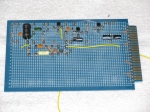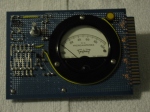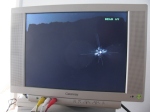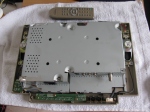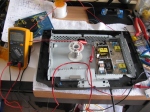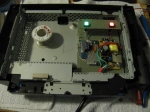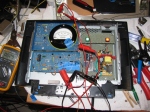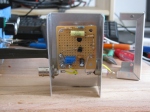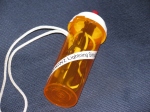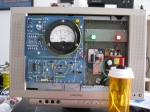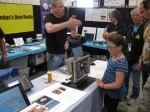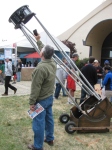Archive for the ‘SDR’ Tag
Not Your Grandpa’s Ham Radio 2016
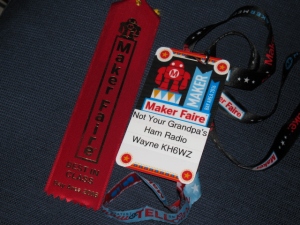
Update
Not Your Grandpa’s Ham Radio Wins ‘Best in Class’ Ribbon
Maker Faire Bay Area was extra-special for us this year: We won a ribbon for “Best in Class.”
Maker Faire Hq. explains there are two ribbon categories: a blue ribbon for best in show, and a red ribbon for best in class. The red ribbons are also used to show the Maker has an educational element.
This red ribbon is an excellent victory, because the Maker Faire staff recognizes for our mission statement:
To show people what today’s ham radio operators are doing with the newest technology, and to change the image of ham radio, making it both contemporary and chic in a hi-tech way. We also want to emphasize how ham radio can be used for science and technology education and a possible career path for youngsters.
Our projects demonstrate how ham radio technology changes with the times, yet still includes both past and present to accomplish one thing: Creating ways to communicate voice and data over the ether, without wires.
Maker Faire Hq. keeps track of Makers as they (we) win ribbons.
Notice several Makers have multiple ribbons. Now we have an additional Maker Faire goal: We need to win a ribbon each year.
Maker Faire Bay Area Team 2016
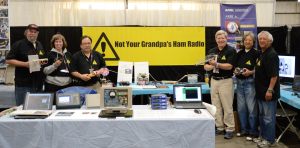
Left to right: Dennis Kidder W6DQ, Lisa Gibbons KF6QNG, Wayne Yoshida KH6WZ, Marty Woll N6VI, Patricia Yee, Brian Yee W6BY. Not pictured: Joel Wilhite KD6W, Victor Frank K6FV and Paul Zander AA6PZ. The new polo shirts made by Dennis gave booth staff a professional look. Photo by Dennis Kidder.
A Setup Day Tradition and Treat – Gerard’s Paella
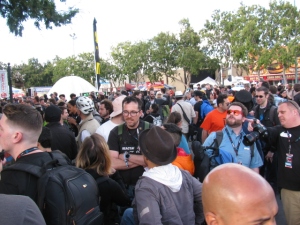
Hungry Makers ready for paella and various beverages after setting up their displays and activities.
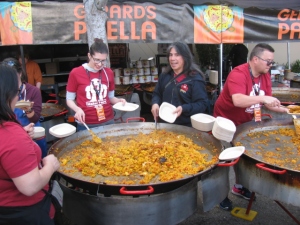
Volunteers scoop and serve paella to the Makers after Maker Faire Bay Area setup day.
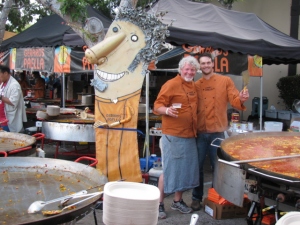
Gerard and his nephew Tom as the paella feast winds down.
This is a tradition at the Maker Faire Bay Area: Gerard’s Paella. Gerard Nebesky trucks in his crew and giant paella pans, which are about 20 feet in diameter. Gerard feeds over 2500 hungry Makers on Friday evening. A great big Thank You goes out to Gerard and his Maker Faire crew!
Here’s a quick video of the paella feast at the 2014 Bay Area Maker Faire.
New Projects
Lightning Detector, Low Frequency (300 kHz) Receiver
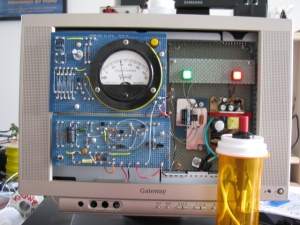
The completed lightning detector-300 kHz receiver completed a few nights before the Maker Faire. On the right is the “lightning simulator” – a piezo BBQ striker in a plastic pill bottle.
The lightning detector-300 kHz receiver is built into a broken LCD TV cabinet. Originally, I thought I could re-use the power supply, infrared remote control and audio amplifier. Unfortunately, the TV is built with a small number of ICs with multiple functions. The power supply performed strangely when I probed around to map out the output voltages. Since I was on a tight schedule, I gutted the unit, and kept only the speakers.
Lightning flashes and Tesla coils generate a wide range of radio frequencies near 300 kHz, slightly below the AM broadcast band (540 kHz to 1700 kHz). The electrical impulses can be perceived as “noise” or “static” in a radio receiver.
The Lightning Detector is a “resonant tank circuit” which detects the electrical impulses, amplifies them so the noise can be heard on a speaker, seen on the yellow LED and moves the needle on the meter.
A lightning simulator is used to test or demonstrate the unit in action when no storms are in the area. It is a low frequency, low level oscillator. Another way to simulate lightning is to use a piezo electric striker, like the ones used in some cigarette lighters and gas barbecue starters.
Information on this circuit comes from Charles Wenzel’s Technical Library (TechLib). There are a lot of interesting projects and includes a gallery of readers’ projects.

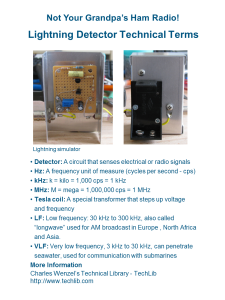
A Software Defined Radio – Made with Vacuum Tubes
A what made with what?
This is an interesting mix of old and new. Dennis Kidder, W6DQ, came up with this idea. Vacuum tubes are fully capable of performing many of the same functions as modern solid-state devices.
Dennis says, “The best part of using tubes in a project — they look really cool!”
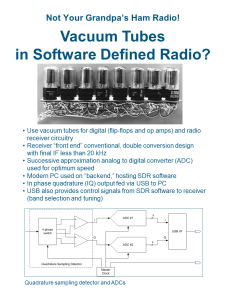
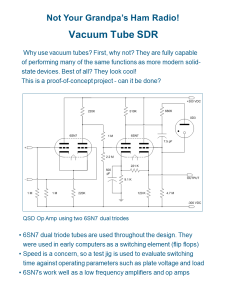
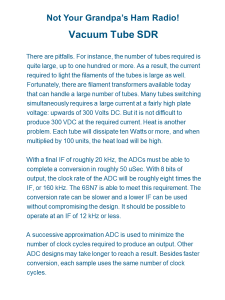

24 GHz Beacon

Brian Yee, W6BY, brought his Amateur radio beacon. A beacon is a one-way radio transmitters usually used as “propagation indicator” to help see how signals are traveling through the air. They can also be used as a signal source or reference to measure frequency, calibrate radio receivers and test antennas. Brian’s beacon operates on the 24 GHz band, and is made with modified microwave telecommunications sub-assemblies. An Arduino Nano is used as the beacon identifier. It sends out Brian’s ham radio callsign W6BY every 10 minutes (an FCC requirement) as well as a series of tones to help locate and identify the beacon.
N6VI Antenna and Spectrum Analyzer Demonstration
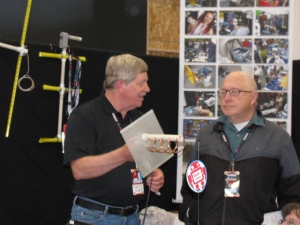
Marty Woll brought a portable spectrum analyzer and an assortment of hand-built antennas, including this corkscrew (circular polarized) antenna. A weak signal source was placed at the far end of the booth. By moving the antenna around, the spectrum analyzer shows frequency and signal strength. This can visually demonstrate antenna polarization and direction as well as frequency and harmonics.
KH6WZ 10 GHz Transmitter-Receiver System
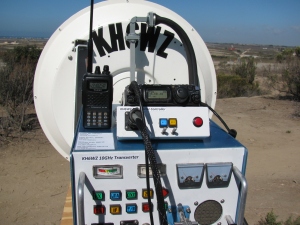
The “anchor project” from past events is my 10 GHz transverter system. This station is used to demonstrate and explain frequency multiplication and division, frequency up-conversion (transmitting), down-conversion (receiving), polarization and antenna directivity to non-hams and even children.
W6DQ Software Defined Radio (SDR) Demonstration
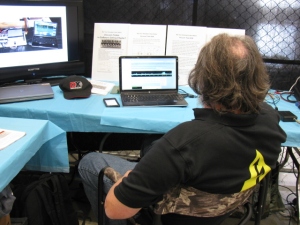
Dennis Kidder W6DQ, displayed his software defined radio (SDR). There were many questions about SDRs and many visitors were surprised to learn ham radio operators have this technology. But this is another example of what radio hams are using these days.
Virtual Air Traffic Control Receiving Station Using ADS-B – Automatic Dependent Surveillance – Broadcast
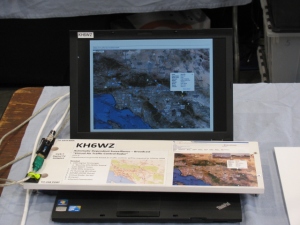
ADS-B is the “next generation” air traffic control, to replace/supplement ground-based radar. Each aircraft transmits identification, GPS position, flight information and other data.
It is very easy to make an ADS-B receiving station. Here are the things needed:
- A digital TV (DVB-T) dongle – DVB-T is Digital Video Broadcast – Terrestrial, a digital TV standard used in Europe and other, non-North American locations
- Antenna for 1090 MHz, this can be built with cable TV coaxial cable and a few other items.
- Windows PC
- ADSB# (ADSB Sharp), a free application
- Virtual Radar Server, another free application
- Browser and Internet Connection
An inexpensive (less than $20 US) digital TV software defined radio in a USB dongle is used to decode ADS-B signals. Free downloadable applications for Windows PCs are used to decode and display the live air traffic broadcasts on a computer.
There is one important thing to know when buying your DVB-T dongle: The decoder and display programs work only with dongles using the Realtek RTL2832U with the RaefaelMicro R820T Tuner chip set.
More ADS-B Receiver Information
“Virtual Radar from a Digital TV Dongle,” QST, January 2014
ADSB# (SDR Sharp) – Download
Virtual Radar Server – Download
Broadband-Hamnet™ (formerly called HSMM-Mesh™) Demo
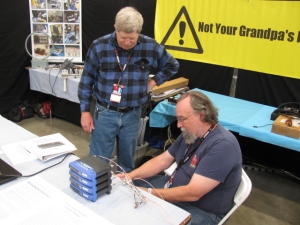
Dennis W6DQ (seated) assembling the BBHN network demo as Marty N6VI asks a few questions about the network.
Broadband Hamnet (BBHN) re-purposes commercial Wi-Fi equipment to operate only in the ham bands to create robust, wireless, IP-based networks suitable for emergency communications or remote monitoring and control.
Commercial Wi-Fi equipment is restricted through FCC Part 15 regulations, limiting power and range and precluding the user from modifying type-accepted products.
However, licensed ham radio operators are legally allowed to modify Part 15 devices to make them operate in the FCC Part 97 rules for ham radio operation. Larger antennas, higher power, adding receiver pre-amplifiers and other techniques are allowed for experimentation.
The result is a system which creates an ad-hoc, meshed network, supporting IP traffic, e.g., voice, video and data. A meshed wireless network affords greater reliability by providing alternative route paths in the event of a failure.
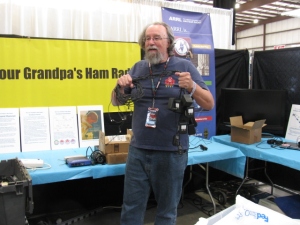
Dennis says there sure a lot of wires needed for wireless networking.
Note: There are two systems for amateur radio wireless networking – Broadband HamNet (BBHN) and Amateur Radio Emergency Data Network (AREDN). If you are interested in experimenting with this, check with others in your area to see what they are using.
10 GHz / 24 GHz Dual Transmitter-Receiver System
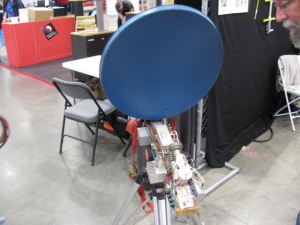
Joel Wilhite KD6W constructed a 10 GHz and 24 GHz dual-band transverter system for portable use. It consists of various modified modules from several sources.
We encourage kids and parents to talk to each other using our home-built radios. It helps make things more interesting than just looking at things.
UPDATE — See what Dennis W6DQ and I did for the San Diego Maker Faire!

This is our fourth consecutive year as Makers. The 2015 SD Maker Faire team is Dennis W6DQ and Wayne KH6WZ.
Our mission is to change the image of ham radio, making it both contemporary and chic in a hi-tech sort of way. We also want to emphasize how ham radio can be used for science and technology education and a possible career path for youngsters.
Amateur, or ham radio has always included teaching-learning-making-modifying-hacking and networking (making new friends) traditions for over a hundred years. We want to remind people this “new Maker Movement” is not really a new idea. Read my LinkedIn Publish post called “The Original Makers” to learn more about this.
We also want to show everyone that ham radio technology changes with the times, and continues to include both past and present to accomplish one thing: Creating ways to communicate voice and data over the ether, without wires.
Here are some of the projects on display – stay tuned for more stories and pictures after the event!
-

-
Live virtual air traffic control radar receiving station
-

-
Homemade antenna
-

-
APRS / location tracker demonstration
-

-
Software defined radio modules. Photo by Dennis Kidder, W6DQ
-

-
Broadband ham radio network under construction
By the way – here are 65 reasons why ham radio continues to survive – and possibly thrive – in a world of instant, global communication fro everyone:
65 Great Things About Ham Radio
CQ magazine celebrates its 65th anniversary by making a list of 65 great things about ham radio. Ham radio can be considered one of the earliest forms of “social media,” “networking” and “making.” Items in italics can be considered “life lessons.”
1. It works when nothing else does
2. It makes you part of a worldwide community
3. The opportunity to help neighbors by providing public service and emergency communications
4. Some of the nicest people you’ll ever meet
5. Some of the smartest people you’ll ever meet
6. Some of the most interesting people you’ll ever meet
7. Some of the most generous people you’ll ever meet (along with some of the cheapest!)
8. Lifelong friendships
9. Friends around the world (including those you haven’t met yet)
10. The opportunity to go interesting places you might not otherwise go to
11. The opportunity to do interesting things you might not otherwise get to do
12. The opportunity to expand your knowledge of geography
13. The opportunity to expand your knowledge of earth and space science
14. Practical uses for high school math
15. Practical uses for high school physics
16. A good way to practice a foreign language
17. A good way to keep in touch with faraway friends and relatives
18. A good way to get driving directions when visiting someplace new (with or without GPS)
19. A good way to find the best places to eat when visiting someplace new (with or without GPS)
20. Finding “non-touristy” off-the-beaten-path places to stay, eat, visit, etc.
21. A good way to learn about virtually any topic
22. A good way to bridge the generation gap
23. A good way to keep tabs on elderly/infirm people
24. People named Joe (Walsh, Rudi, Taylor)
25. How many of your non-ham friends have actually talked to someone in some remote place such as Cape Verde or the Seychelles?
26. How many of your non-ham friends might have talked to an astronaut aboard the space station?
27. How many of your non-ham neighbors might have a satellite uplink station in their basements—or in the palms of their hands?
28. How many of your non-ham neighbors might have a TV studio in their garage?
29. What other hobby group has designed, built, and had launched its own fleet of communication satellites?
30. Where else can you play with meteors?
31. Moonbounce
32. Informal way to improve technical skills
33. Informal way to improve communication skills
34. Introduces a variety of career paths
35. Offers unparalleled opportunities for career networking
36. Opportunities for competition in contesting and foxhunting
37. A good way to collect really cool postcards from around the world (despite the growth of electronic confirmations)
38. Nearly endless variety of different things to do, on and off the air
39. Hamfests
40. Dayton
41. Field Day
42. Working DX
43. Being DX
44. DXpeditions
45. Contesting
46. Award-chasing
47. Double-hop sporadic-E
48. Worldwide DX on 6 meters (once or twice every 11 years) [The current extended sunspot minimum has shown that mechanisms other than F2 propagation can offer intercontinental DX on the “magic band” at any point in the solar cycle.]
49. Tropospheric ducting
50. Gray-line propagation
51. TEP, chordal hops, etc.
52. Getting through on CW when nothing else will
53. Unexpected band openings
54. Building your own gear
55. Using gear you’ve built yourself
56. Operating QRP from some remote location
57. Experimenting with antennas
58. Working DX while mobile or while hiking
59. Experimenting with new modes and new technology
60. The opportunity to help build an internet that doesn’t rely on the internet
61. DXing on your HT via IRLP and Echolink
62. Contributing to scientific knowledge about propagation
63. Keeping track of other people’s GPS units via APRS
64. Ham radio balloon launches to the edge of space, and as always…
65. Reading CQ!
Take a look at the CQ magazine website to find more interesting things about ham radio.
32.715738
-117.161084
October 3 and 4: Maker Faire® San Diego!

Maker Faire San Diego is October 3 and 4, 2015, from 10 AM to 6 PM at Balboa Park. Our “Not Your Grandpa’s Ham Radio” theme will feature some new projects as well as some of the old, but popular demonstrations from previous Maker Faire events. Pictured below is a project under construction, I hope to have it completed for this event. It is a homemade 1090 MHz collinear (vertical) antenna that will be part of an air traffic control monitoring station using a software defined radio (SDR).

October 15 to 18: Microwave Update (MUD)!

Microwave Update, or MUD, is a yearly technical conference for amateur radio experimenters making, modifying, hacking, building, testing and using the 1,000 MHz and up radio bands. Participants from all over the world gather at these events to share information about operating techniques, radio propagation and radio station equipment. One aspect of this event is the buying, selling and trading of surplus parts and assemblies for these frequency bands, since some items may be difficult to procure in some areas. But perhaps the best thing about MUD is socializing and making new friends from all over the world to discuss common interests and goals.
Preparations for the San Diego MUD are still under way. Last weekend, a few San Bernardino Microwave Society (SBMS) members gathered at Dave’s lab to sort and package some prize and give-away items for the event.

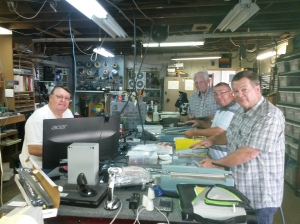
Left to right: Dave WA6CGR, Rein W6SZ, Pat N6RMJ and Jim KK6MXP sorting and packing some microwave frequency prizes and give-ways.
I hope to see you at any or both of these events!
Since pictures are worth a thousand words, here is a 2015 Bay Area Maker Faire recap in images from and around our Not Your Grandpa’s Ham Radio theme booth.
Click here to see the official Bay Area Maker Faire video from 2015
The Bay Area Maker Faire 2015 team: Team Leader Brian Yee W6BY and his wife Pat and daughter Stephanie, Dennis Kidder W6DQ, Lisa Gibbons KF6QNG and Paul Zander AA6PZ
We had working, hands-on ham radio projects including Brian’s (W6BY) 10 GHz ham radio transverter system, a radio-controlled tractor/forklift (ZigBee controller) and the big screen used as an electronic sign.
Dennis W6DQ brought several brand new projects this year, including a working Amateur Radio broadband (WiFi) network with seven nodes, a software-defined radio (SDR) system.
I brought a demonstration comparing old and new technology in antenna tuners. It uses light bulbs for a substitute (“dummy”) antenna.
-

-

-

-
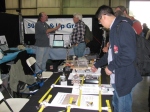
-

-
Lisa showing the new Arduino book to an interested Maker
-

-
Stephanie shows off her “Lear to Solder” badge of honor
-

-
Guys at the Nepal ham radio booth
-

-

There’s so much to see and do. Here are some pictures of what I get a chance to see.
Always great to see Tenaya promoting Arduino and Arduino related projects and products!

Great shirts and signage – Only at the Maker Faire!
Here are the posters we used to describe our projects on display this year.








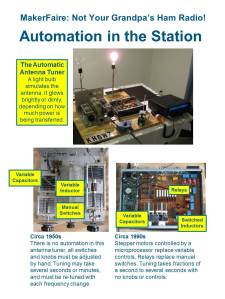






Maker Faire Bay Area 2015 T-Shirts for Makers
Maker Faire Bay Area is now history. Our booth, “Not Your Grandpa’s Ham Radio” included new projects and demonstrations. This was our fourth year as Makers and the fifth year as visitors to the Maker Faire in San Mateo.
This is a short overview of our display. Stay tuned for more images, stories and videos.
Here is the text from our handout. It answers some of our most-often asked questions:
What are we doing?
Thank you for your interest in our Maker Faire display “Not Your Grandpa’s Ham Radio.” This is our fourth consecutive year as “Makers,” and our goal is to show people what today’s ham radio operators are doing with the newest technology.
Who are we?
We are licensed Amateur radio operators (“hams”).
Is this like CB?
Yes and no. Ham radio is similar in that we use two-way radios and antennas to talk with each other, but hams can communicate using Morse code and computers in addition to voice, and we even have our own satellites. Ham radio requires a license issued by the Federal Communications Commission (FCC) in the US and licensees are required to pass a written test on electronics theory, radio regulations and operating procedures.
How far can you talk?
We can communicate with other ham stations around the corner or across the globe, depending on a variety of factors that affect the way radio waves travel. The equipment we are using operates on frequencies that generally follow line-of-sight paths. However, hams have discovered that signals can be reflected against objects such as buildings, trees, islands and mountains to extend the range. Using these techniques, we are able to contact other stations hundreds of miles away.
What kind of radios are you using?
We are builders and experimenters in microwave radio communications. No commercially-built, “off-the-shelf” equipment for these frequencies exists, so we must build our own equipment, or modify commercially-made equipment meant for other communications services, such as satellite TV, cell phone and long-distance telephone.
How much does this equipment cost?
Like any other hobby, people spend as much or as little as they can afford. Most people involved in ham radio spend as much as any serious stereo enthusiast, amateur photographer or woodworker.
Where can I get more information?
American Radio Relay League (ARRL) and QST Magazine
CQ Magazine
If you are a licensed ham and want to try a new challenge, contact your local VHF and up club:
The 50 MHz and Up Group
The San Bernardino Microwave Society (SBMS)
The Microwave Group of San Diego
Wayne Yoshida KH6WZ: YouTube
Broadband Hamnet-REV2

Broadband Ham Radio Network Under Construction. Photo by Dennis Kidder W6DQ
Software Defined Radio

Elements for the SDR. Photo by Dennis Kidder W6DQ
Old-vsNew-Ant-tuners

Old vs New Antenna Tuner Technology
KH6WZ 10GHz rig-Poster

Microwave transverter system by Brian Yee W6BY. Photo by Brian Yee W6BY
APRS Poster

APRS demonstration

The Greeter
This is our third consecutive appearance at the Bay Area MF, and continues my theme of showing how some ham radio operators continue the tradition of “teaching, mentoring, making, modifying, repairing and improving” radio and radio-related technology. Read my post about ham radio and the Maker movement.
Today’s ham radio operators have an incredible amount of exotic surplus material that can be converted into everyday use on the ham radio bands. Grandpa certainly never heard of surface-mount technology, talking on homemade 47 GHz transmitter-receiver systems or pocket-sized, satellite navigation systems (GPS). But he sure did mentor, make, modify, repair and improve the equipment in his bedroom radio station…..
Not Your Grandpa’s Ham Radio – Maker Faire 2014 Team
Wayne Yoshida KH6WZ
Dennis Kidder W6DQ
Brian Yee W6BY
Marty Woll N6VI
More information on the Maker Faire Bay area.
Here is a gallery of our booth posters for the 2014 Bay Area Maker Faire. More photos, videos and stories will follow. . . . .
Discovery Science Center – Advanced Ham Radio on Display at the Meet the Makers Event
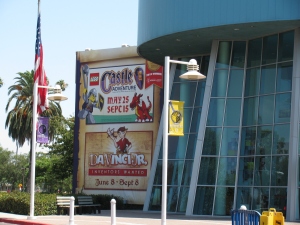
Signage at The Discovery Cube announces the Meet the Makers Event
Dennis Kidder (W6DQ), Walter Clark and I demonstrated our Maker Faire ham radio projects at the Discovery Cube in Santa Ana on June 29 and 30, 2013. We used my TinyTrak APRS beacon to indicate our location during the event. In case the plot is removed or expires, here is an image of the map showing our location. KH6WZ is indicated by the eye icon near the Interstate 5 freeway in Santa Ana.

This is a screen capture showing the KH6WZ APRS beacon data from the Discovery Science Center – Meet the Makers event.
This was a great opportunity to expose people to today’s technology Amateur Radio, and continued along my Maker Faire theme, “Not Your Grandpa’s Ham Radio.”
Dennis brought his dual band 10 GHz and 24 GHz transverter, controlled and interfaced to his software-defined radio (SDR).
Walt brought his polarization demonstration units, which helped people visualize how radio signals propagate and change as they travel through the air. Here’s how Walt explains his demos:
Two demonstrations show the structure of radio waves – in this case microwaves.
One
The structure of a radio wave in angle around the direction of travel: This is called polarization. A spinning bargraph that has a receiving antenna that also spins will reveal the way radio waves “look” to a receiving antenna. The lesson here is that the receiving and transmitting antennas have to be oriented to the same angle.
Two
The structure of a radio wave along the direction of travel: When a receiver is arranged to look exactly in [or along] the direction the radio waves are going out, reflections can be measured; just like in radar. The reflection off of the hand or the chest of a person causes the speaker to be loud or quiet depending on the exact position. It cycles from loud to quiet every 1.5 cm whether inches or many feet away. The lesson here is that with this equipment, you can picture in your mind the wavelength and especially note that the wavelength is the same no matter how far the radio wave travels.
We did not establish any goals for this event, but there were several memorable visitors to our little table display, including teachers, Maker Faire participants, some current and ex-ham radio operators, many engineers and retired engineers as well as engineering students.
This “Meet the Makers” event was a double treat for me, since this was the first time I visited the Science Center, and I had a blast talking about the new technologies being used by today’s ham radio enthusiasts.
Here are some pictures of this event . . .
-

-
An R/C R2D2 makes an appearance at the Meet the Makers event at the Discovery Science Center.
-

-
The 24-inch dish antenna makes a great stand for signage.
-

-
The KH6WZ APRS beacon display at the Meet the Makers event.
-

-
Dennis W6DQ, brought his software defined radio with 10 GHz and 24 GHz transverter to our exhibit.
-

-
Walt brought several fascinating displays to illustrate radio wave propagation.
-

-
Dennis explaining the radio wave demonstration to our target audience: kids.
-

-
Great shot of Walt explaining radio wave propagation to some visitors.
-

-
The Science of Hockey at the Discovery Science Center
-

-
A close-up of one of Walt’s displays
Acknowledgements
Thanks to Bequi Howarth, of the Orange County Mini Maker Faire, who introduced us to the Discovery Science Center.
Links to More Information
Byonics (TinyTrak APRS and Weather Units)
Discovery Science Center, Santa Ana, CA
Orange County Mini Maker Faire, University of California, Irvine (UCI)
Maker Faire
Make: Magazine
American Radio Relay League (ARRL)
CQ Magazine
San Bernardino Microwave Society (SBMS)
Wayne Yoshida LinkedIn Profile

This past weekend, some of the active San Bernardino Microwave Society (SBMS) gathered at Fairview Park in the early morning to perform a field test of their microwave systems. Since I did not do anything with my rigs this past year, I decided to skip this field test, and take some pictures of any new more interesting rigs for this contest season.
Here are some pictures of the various station equipment SBMS club members built and tested that day . . .
A post-Tune Up Party party and BBQ was held at Dennis W6DQ’s house. It was nice to relax and visit with the other SBMS members and enjoy some great BBQ chicken….. In the picture below, Walt, WALT explains one of his radio wave demonstrations to a captive audience… Watching and learning, from left to right are Bill Preston, KZ3G; Dan Slater, AG6HF and wife Sandy Slater; Walt, and Jason Sogolow, W6IEE.
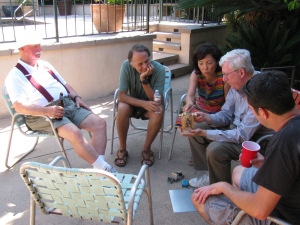
If you are curious about the test setup, here is an article written by Kerry Banke, N6IZW, with some small edits by me:
Checking Microwave Radio Performance with a Simple ERP/MDS Test Unit
By Kerry Banke, N6IZW (Edited by Wayne Yoshida, KH6WZ)
Before heading for the hills with 10 GHz equipment around contest time, members of the San Diego Microwave Group (SDMG) and the San Bernardino Microwave Society (SBMS) check the Effective Radiated Power (ERP, transmit) and Minimum Discernible Signal (MDS, receive) with the simple setup described in this article. We hold the test sessions at the June and July meetings in preparation for the ARRL 10 GHz and Up Contest in August and September. The advantage to having two sessions is that it provides a second opportunity to verify improvements or allow participation if the first session is missed. The test unit works with both wide band and narrow-band radios.
The Pole-Mounted Test Setup
The setup consists of a pole mounted X-Band converter unit connected by coax to a signal source (for MDS) and an amplifier/power meter located near the radios to be tested some 200-300 feet away. The MDS test must be performed first to align the radio antennas with that of the converter. A signal generator is connected to the IF coax and a suitable frequency (145 MHz) and power level (-40 dBm set to transmit an easily detectable carrier around 10368 MHz at the output of the converter.
MDS for Receive
Each participant adjusts their equipment and the system antenna for maximum signal as the power level of the signal generator is reduced to the point where it is no longer detectable by the radios. The level at which the signal can just be detected is considered the MDS.
ERP for Transmit
The ERP measurement is performed by connecting the IF coax to the amplifier and power meter. Each radio transmits one at a time and the power meter reading recorded. The variable attenuator is adjusted to keep the reading in a suitable power range for the power meter and amplifier. For the amplifier used, the maximum output power was about +10 dBm and the power meter range is about –20 to + 10 dBm so the attenuator was adjusted to keep the reading in the –20 to 0 dBm range.
The choice of the IF frequency for the converter depends on what is available for a 10 GHz local oscillator but needs to be low enough to keep the losses reasonable through hundreds of feet of coax. The amplifier gain and maximum output need to be based on the power meter characteristics. The signal generator needs to match the IF frequency chosen, have suitable stability for CW work (NB only), and have variable output (may be an external attenuator).
The converter consists of a Frequency West Brick as a 10,223 MHz local oscillator for a mixer used as an upconverter for MDS and down converter for ERP. The converter has a 13 dB horn antenna connected to the mixer RF port. Power is supplied by a 12V battery on the ground with a DC/DC converter supplying the required voltage for the local oscillator. The coax used is 300 feet of RG-59 which was readily available. No attempt to correct matching losses for the 75 ohm coax has been made. The loss of the coax and mixer as well as the amplifier gain was measured at the operating frequencies. It is not really necessary if only relative measurements are to be performed but it does allow a good comparison between measured and calculated values.
The results of the test are entered into a spreadsheet, which then calculates the ERP based on dish size in inches and estimated PA output of the radio under test. The distance in feet from the radios to the converter is input to the sheet, which then calculates the path loss in dB. For ERP, the sheet provides calculated ERP, measured ERP and the difference between them. For MDS at this time, only the signal generator level is recorded and is used for relative measurements.
Block diagrams for the 10 GHz and 24 GHz units are described in the PDFs below:
10 GHz ERP-MDS Block Diagram
24 GHz ERP – MDS Block Diagram
Intro to the MDS/ERP Event Results
(From an entry on the SBMS website on August 10, 2012)
These spreadsheets show the results of workshops/picnics where amateur microwave stations were compared on a unique test range for both transmitting and receiving performance. The test setup was developed by Kerry Banke, N6IZW and has been used by the San Diego Microwave Group (SDMG) and the San Bernardino Microwave Society (SBMS) over the past few years. The test setup consists of a remote TX/RX transmitter/sensor unit installed on a pole about 15 ft. high at a distance of approximately 220 ft. from the stations being tested.
The remote transmitter produces a stable signal on the operating frequency, such as 10368 MHz. Operators tune this in with their rigs and peak their antennas. The signal is then reduced in level until barely discernible (MDS). That level is logged. The operator then transmits with maximum CW power and the RX sensor power level is logged. The spreadsheet is used with the logged data and with data on each rigs claimed antenna size and transmit power to allow comparison of measured versus expected performance.
The results have been useful, not from an absolute basis, but by allowing operators to compare their rig’s results against other amateur’s rigs having similar TX, RX, and antenna characteristics. Any major performance differences between systems can help focus on problems that can be solved before upcoming contest events.
In past events, operators have discovered problems with relays, cables, connectors and even non-functioning power supplies.
Interpreting Results
Receive (MDS) performance is shown in the column marked “MDS Gen dBm.” You want the largest negative value compared to other stations having the same size or performance antenna on that frequency band.
In the last column marked “Meas-Calc,” transmit ERP performance is shown. A zero means that the ERP came out exactly as expected given the claimed transmitter power and antenna gain. A positive number indicates an ERP that is better than expected by that many dB. A negative number indicates system performance measures worse than expected.
Here are some results over the past years – 2013 results added!
TuneUp2013
SDMG ERP-MDS-2013 Results
TuneUp-2012
TuneUp-2011
TuneUp-2010
TuneUp-2009
Tune-Up-2008
TuneUp-2007
TuneUp-2006
TuneUp-2005
TuneUp-2004
TuneUp-2003
TuneUp-2002
TuneUp-2001
TuneUp-2000

Maker Walt discussing something fascinating with Jeri Ellsworth, aka “Circuit Girl.” Photo by Tony KC6QHP
Here is a report on the 2013 Maker Faire by Tony Long (KC6QHP):
Another great Maker Faire is in the books, amateur microwave radio was well represented!
Thanks to the coordination efforts of Wayne KH6WZ, Brian W6BY, the 50 MHz and Up Group, the SBMS, and UC Davis, the “Not Your Grandpa’s Ham Radio 2” booth at the Maker Faire was a great success.
This year we shared a booth with UC Davis whose impressive student projects ranged from a radar demonstration, to video processing, audio sequencing, and mechatronics. Along with that, we had a 10/24 GHz SDR setup courtesy of Dennis W6DQ (on a big screen courtesy of Brian), some of Brian’s homebrew gear, Walt’s EM field demos and transceivers, and some of my stuff including a 10 GHz radio and beacon.
LA Times says that about 165,000 people were expected to attend this year, so at a minimum 10,000 people passed by our booth. Our raspy voices are an indicator that a great deal of talking was done! I personally interacted with a number of people who are really interested in amateur microwave radio and if even a fraction of them get involved or raise general awareness, I think it is a success.
Walt’s demos, owing in part to their elegant simplicity and visual nature attracted a lot of attention and interest. On Sunday night he took them to a post-fair get-together with the who’s who of the hardware hacking scene (Jeri Ellsworth, Ben Heckendorn, Diana Eng, Alan Yates and many many others). All were impressed!
Something I see very encouraging in the “maker” scene is a real interest in RF. This crowd includes a good deal of embedded systems engineers, talented software people, etc. There’s a real opportunity to make connections with this crowd and get more activity on the microwave bands.
As Software Defined Radios decrease in cost and become more open source, I predict massive interest in RF and likely in the microwave bands because of their large bandwidths. While they may not be interested in SSB mountaintop to mountaintop contesting (there will be those who are certainly), an increase in use of our bands will only help to further the cause of maintaining our spectrum to help further the state of the art.
I posted a gallery of pictures on Flickr: http://goo.gl/cAy3p
Tony KC6QHP”
Thanks for the report, Tony!





